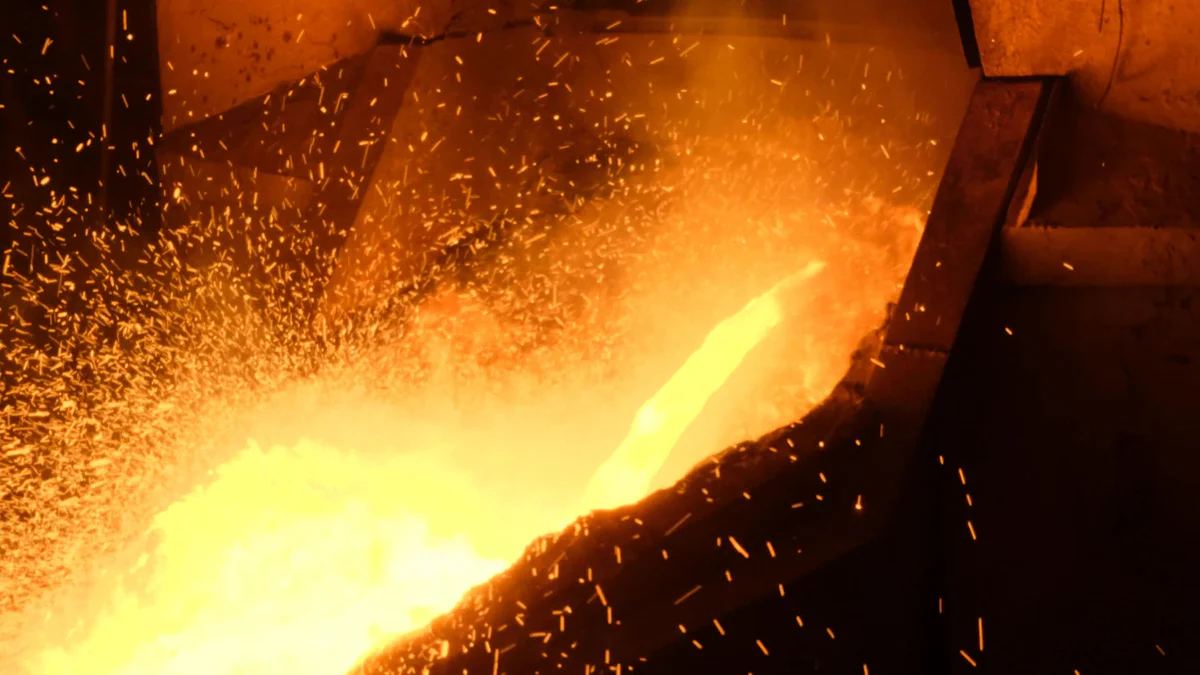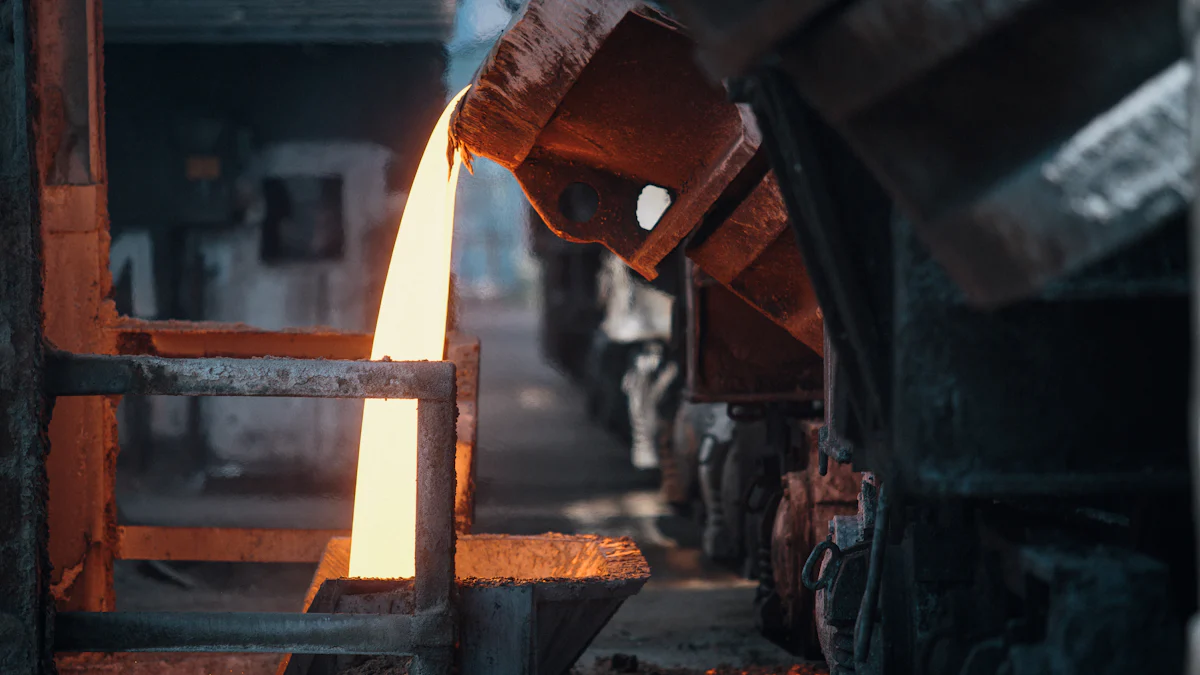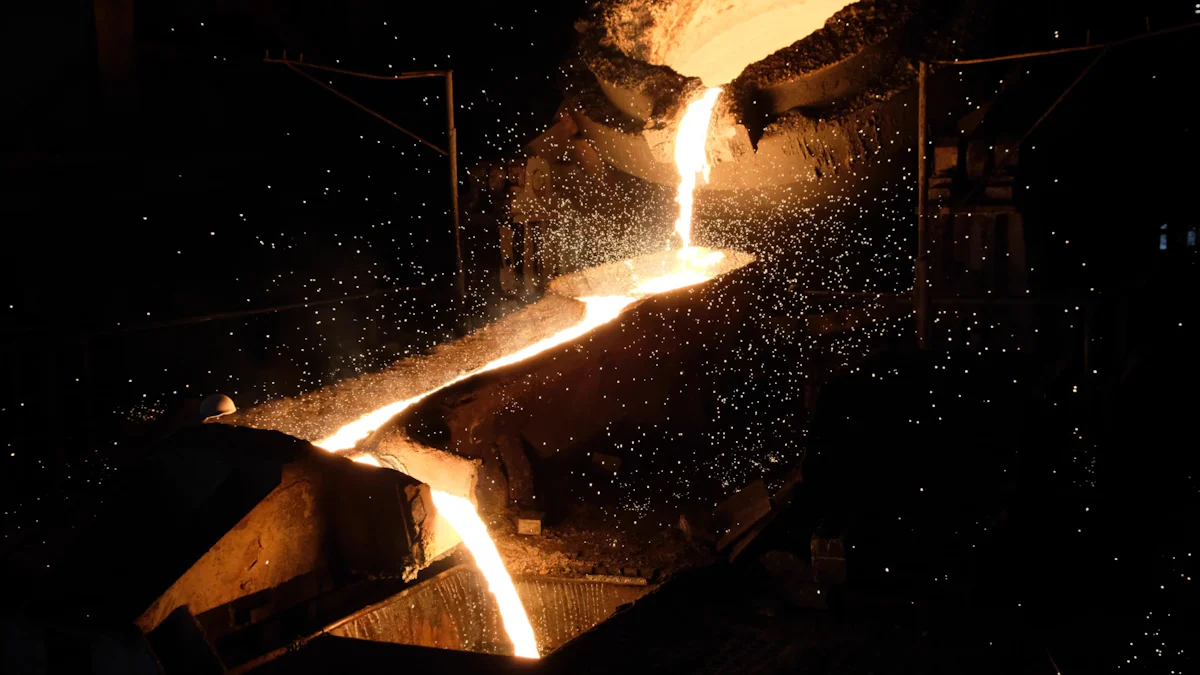
The melting point of iron stands at a remarkable 1,538°C (2,800°F or 1,811K). This high temperature reflects the robust metallic bonds that hold iron atoms together. I find it fascinating how these bonds require substantial heat to break, making iron a critical material in various industrial applications. Iron’s melting point is not just a number; it signifies its resilience and versatility. Understanding this property helps us appreciate why iron remains a cornerstone in metallurgy and manufacturing, where precise temperature control is crucial.
Key Takeaways
- The melting point of iron is 1,538°C (2,800°F), a critical factor in its strength and durability, making it essential for high-temperature applications.
- Understanding the melting point is vital for industries like metallurgy and manufacturing, as it ensures efficient processes such as casting, forging, and welding.
- Different types of iron, including pure iron, cast iron, and wrought iron, have varying melting points that influence their applications and performance.
- Alloy composition significantly affects the melting point; for example, steel typically melts at lower temperatures than pure iron, allowing for tailored material properties.
- Impurities in iron can lower its melting point, impacting its strength; controlling these impurities is crucial for maintaining high-quality outcomes in manufacturing.
- Comparing iron’s melting point with other metals, like aluminum, highlights its suitability for demanding environments, while aluminum’s lower melting point offers advantages in lightweight applications.
- By understanding the melting point and its implications, professionals can make informed decisions about material selection, ensuring optimal performance in various industrial projects.
Importance of Knowing the Melting Point of Iron
Understanding the melting point of iron is crucial in various industries. This knowledge plays a significant role in both metallurgy and manufacturing, ensuring that processes are efficient and products meet high-quality standards.
Role in Metallurgy
In metallurgy, the melting point of iron is a fundamental property. I often find myself amazed by how this single characteristic influences so many aspects of metal processing. For instance, casting, forging, welding, and heat treatment all rely on precise temperature control. When I work with iron, I must ensure that the temperature is managed correctly to maintain the integrity of the material. This precision helps in producing components that are not only durable but also resistant to wear and corrosion. The melting point acts as a guide, allowing me to manipulate iron effectively during these processes.
Applications in Manufacturing
Manufacturing industries also benefit greatly from understanding iron’s melting point. In my experience, knowing this property is essential for CNC machining services. It helps in determining the right conditions for machining different types of iron. By understanding the melting point, I can ensure that the products remain robust and reliable. Iron’s versatility and abundance make it a staple in construction and heavy machinery industries. Its medium melting point facilitates forging and shaping, which are critical in creating complex structures and components. This knowledge not only enhances the performance of iron-based products but also ensures safety in industrial operations.
Comparison of Melting Point of Iron with Other Metals

Understanding the melting point of iron becomes even more insightful when I compare it with other metals. This comparison highlights the unique properties of iron and its suitability for various applications.
Melting Points of Common Metals
When I examine the melting points of common metals, I notice distinct differences that influence their use in industries.
Iron vs. Steel
Iron, with its melting point of 1,538°C (2,800°F), serves as a benchmark in metallurgy. Steel, an alloy of iron, typically melts at temperatures ranging from 1,425°C to 1,540°C (2,597°F to 2,804°F). The variation in steel’s melting point depends on its composition. I find this range fascinating because it allows for the creation of different types of steel, each with specific properties suited for diverse applications. The slight reduction in melting point compared to pure iron makes steel more versatile in processes like casting and welding.
Iron vs. Aluminum
Aluminum presents a stark contrast with its melting point of 660.3°C (1,221°F), significantly lower than that of iron. This lower melting point makes aluminum ideal for applications requiring lightweight materials and easy shaping. I often choose aluminum for projects where weight reduction is crucial, such as in aerospace and automotive industries. The difference in melting points between iron and aluminum underscores the importance of selecting the right metal based on the specific requirements of a project.
Implications of Differences
The differences in melting points among these metals have profound implications. In my experience, the higher melting point of iron and steel makes them suitable for high-temperature applications, such as in construction and heavy machinery. These metals provide the necessary strength and durability required in demanding environments. On the other hand, aluminum’s lower melting point offers advantages in energy efficiency during processing and ease of fabrication. This characteristic makes aluminum a preferred choice for industries focused on sustainability and cost-effectiveness.
By understanding these melting point differences, I can make informed decisions about material selection, ensuring that each project benefits from the optimal properties of the chosen metal.
Types of Iron and Their Melting Points

Understanding the different types of iron and their respective melting points is crucial for anyone involved in metallurgy or manufacturing. Each type of iron has unique properties that influence its melting point, affecting how it is used in various applications.
Pure Iron
Pure iron, often referred to as “commercially pure iron,” has a melting point of approximately 1,538°C (2,800°F). This high melting point results from the strong metallic bonds between iron atoms. In my experience, pure iron is rarely used in its unalloyed form due to its softness and lack of strength. However, its high melting point makes it an excellent choice for applications requiring resistance to high temperatures. For instance, I often see pure iron used in scientific experiments and specialized industrial processes where its purity and thermal stability are essential.
Cast Iron
Cast iron, a popular material in many industries, has a lower melting point than pure iron, typically ranging from 1,150°C to 1,200°C (2,102°F to 2,192°F). The presence of carbon and other impurities in cast iron lowers its melting point. I find cast iron particularly useful in applications where wear resistance and machinability are important. Its lower melting point allows for easier casting into complex shapes, making it ideal for manufacturing engine blocks, pipes, and cookware. The versatility of cast iron stems from its ability to be cast into intricate designs while maintaining durability.
Wrought Iron
Wrought iron, known for its malleability and toughness, has a melting point similar to that of pure iron, around 1,538°C (2,800°F). Unlike cast iron, wrought iron contains very little carbon, which contributes to its ductility and ability to be shaped without breaking. I appreciate wrought iron for its historical significance and aesthetic appeal, often using it in decorative applications such as gates, railings, and furniture. Its high melting point and low carbon content make it less prone to corrosion, enhancing its longevity in outdoor environments.
Understanding the melting points of these different types of iron helps me select the right material for specific applications. Each type offers distinct advantages, whether it’s the high-temperature resistance of pure iron, the castability of cast iron, or the malleability of wrought iron. By considering these properties, I can ensure that the chosen iron type meets the demands of the project, providing both functionality and durability.
Factors Affecting the Melting Point of Iron
Understanding the factors that influence the melting point of iron is crucial for anyone involved in metallurgy or manufacturing. These factors can significantly alter how iron behaves under different conditions, impacting its applications and performance.
Alloy Composition
The composition of an alloy plays a pivotal role in determining the melting point of iron. When I work with iron alloys, I notice that adding elements like carbon, nickel, or chromium can lower or raise the melting point. For instance, steel, an alloy of iron and carbon, typically melts at a lower temperature than pure iron. This variation occurs because alloying elements disrupt the metallic bonds in iron, altering its thermal properties. By carefully selecting alloy compositions, I can tailor the melting point to suit specific industrial needs, enhancing the material’s performance in various applications.
Impurities
Impurities present in iron can also affect its melting point. Elements such as sulfur, phosphorus, and silicon often lower the melting point. In my experience, these impurities can weaken the metallic bonds, making it easier for the iron to transition from solid to liquid. While some impurities are unavoidable, controlling their levels is essential to maintain the desired melting point. I find that refining processes help reduce impurities, ensuring that the iron retains its strength and durability. By managing impurity levels, I can optimize the melting point for specific manufacturing processes, ensuring high-quality outcomes.
Environmental Conditions
Environmental conditions, including pressure and temperature, can influence the melting point of iron. Under high pressure, the melting point may increase slightly. This phenomenon occurs because pressure forces the atoms closer together, strengthening the metallic bonds. Conversely, at lower pressures, the melting point might decrease. I often consider these factors when working in environments with varying atmospheric conditions. Additionally, the cooling process and crystal structure of iron can impact its melting behavior. By understanding these environmental influences, I can better predict and control the melting point during industrial processes, ensuring consistent and reliable results.
Impact of Melting on Iron’s Properties
The melting point of iron plays a pivotal role in determining its structural and physical attributes. When iron reaches its melting point, significant changes occur in its microstructure, which directly influences its applications and performance in various industries.
Changes in Structure
Melting alters the internal structure of iron, transforming it from a solid to a liquid state. This transformation involves breaking the strong atomic bonds that hold iron atoms together. I find this process fascinating because it allows for the reorganization of atoms, leading to new structural configurations upon cooling. The softening-melting properties of iron-bearing materials are crucial in processes like CNC machining. These properties affect the height, thickness, and shape of the cohesive zone in a blast furnace, impacting gas permeability and overall efficiency. By understanding these structural changes, I can better predict how iron will behave under different conditions, ensuring optimal performance in high-temperature environments.
Effects on Strength and Durability
The melting process significantly impacts the strength and durability of iron. As iron transitions from solid to liquid, its mechanical properties change. In my experience, the high melting point of iron indicates strong atomic bonds, which contribute to its robustness and resilience. However, when melted, these bonds break, temporarily reducing the material’s strength. Upon solidification, the cooling rate and environmental conditions can influence the final properties of the iron. Rapid cooling might lead to a more brittle structure, while controlled cooling can enhance toughness and durability. By carefully managing the melting and cooling processes, I can tailor the strength and durability of iron to meet specific industrial requirements, ensuring reliable and long-lasting products.
The melting point of iron, at 1,538°C, plays a pivotal role in its industrial applications. This high temperature ensures that iron maintains its strength and durability under extreme conditions. Understanding this property allows me to optimize processes in metallurgy and manufacturing. Different types of iron, such as cast and wrought iron, exhibit varying melting points due to their unique compositions. These variations influence how I select materials for specific applications. By comprehending these factors, I can ensure that iron-based products perform reliably and safely in demanding environments.
FAQ
What is the Melting Point of Iron?
The pure form of iron has a melting point of approximately 1,538°C (2,800°F). This high melting point reflects the strong atomic bonds within iron, which require significant energy to break. Understanding this property is essential for applications that demand high-temperature resistance.
Why is the Melting Point of Iron Important?
Knowing the melting point of iron is crucial for industries like metallurgy and manufacturing. It ensures that processes such as casting, forging, and welding are conducted efficiently. This knowledge helps maintain the integrity and quality of iron-based products.
How Does Alloy Composition Affect Iron’s Melting Point?
Alloy composition can significantly influence the melting point of iron. Adding elements like carbon, nickel, or chromium can alter the melting temperature. For example, steel, an alloy of iron and carbon, typically melts at a lower temperature than pure iron. This variation allows for tailored properties in different industrial applications.
What is the Difference Between the Melting Point and Boiling Point of Iron?
Iron’s melting point is 1,538°C (2,800°F), while its boiling point is much higher. The melting point is critical for processes like CNC machining, casting, and smelting. Understanding these temperatures ensures optimal performance in manufacturing, allowing for the production of durable and reliable components.
How Do Impurities Affect the Melting Point of Iron?
Impurities such as sulfur, phosphorus, and silicon can lower the melting point of iron. These elements weaken the metallic bonds, making it easier for iron to transition from solid to liquid. Controlling impurity levels is essential to maintain the desired melting point and ensure high-quality outcomes.
What Environmental Conditions Influence Iron’s Melting Point?
Environmental conditions, including pressure and temperature, can affect iron’s melting point. High pressure may increase the melting point slightly, as it forces atoms closer together. Conversely, lower pressures might decrease it. Understanding these factors helps predict and control melting behavior in various industrial settings.
How Does Melting Impact Iron’s Properties?
Melting alters iron’s internal structure, transforming it from solid to liquid. This process breaks atomic bonds, leading to new configurations upon cooling. The melting point indicates strong bonds, contributing to iron’s robustness. Managing melting and cooling processes can tailor iron’s strength and durability for specific needs.
What Are the Types of Iron and Their Melting Points?
Different types of iron, such as pure iron, cast iron, and wrought iron, have varying melting points. Pure iron melts at approximately 1,538°C (2,800°F), while cast iron melts at lower temperatures due to impurities. Wrought iron, with low carbon content, shares a similar melting point with pure iron. Each type offers distinct advantages for specific applications.
How Does the Melting Point of Iron Compare to Other Metals?
Iron’s melting point is relatively high compared to many other metals. For instance, aluminum melts at 660.3°C (1,221°F), significantly lower than iron. This difference highlights iron’s suitability for high-temperature applications, while aluminum’s lower melting point offers advantages in energy efficiency and ease of fabrication.
What Role Does the Melting Point Play in Industrial Applications?
The melting point of iron is pivotal in industrial applications. It ensures that iron maintains its strength and durability under extreme conditions. Understanding this property allows for optimized processes in metallurgy and manufacturing, ensuring reliable and safe performance in demanding environments.
